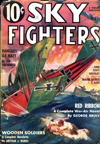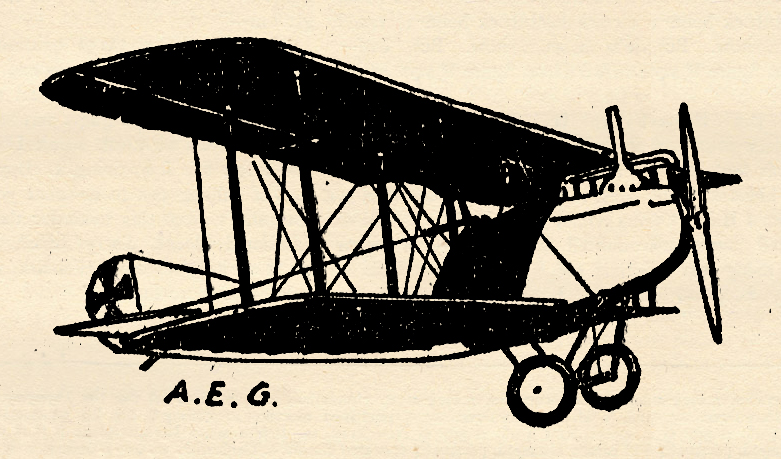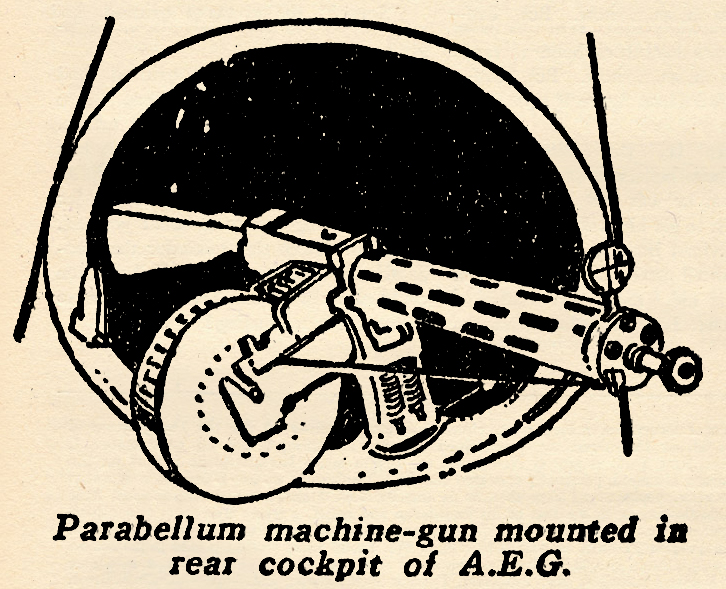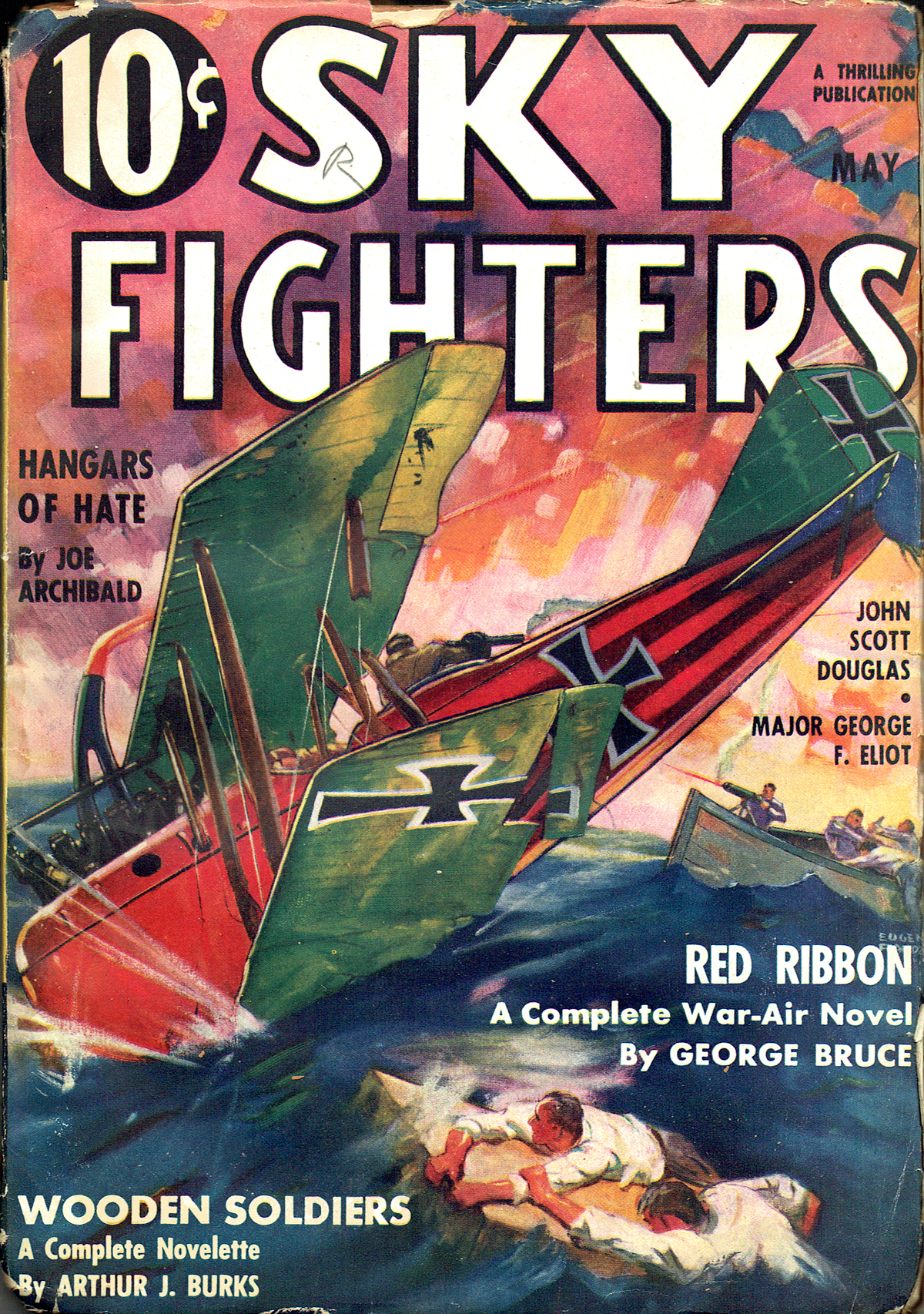“Sky Fighters, May 1936″ by Eugene M. Frandzen
Eugene M. Frandzen painted the covers of Sky Fighters from its first issue in 1932 until he moved on from the pulps in 1939. At this point in the run, the covers were about the planes featured on the cover more than the story depicted. Mr. Frandzen features A.E.G. on the May 1936 cover!
The Ships on the Cover
BEFORE the World War airplanes  were more scoffed at than praised as a possible military weapon. Capitalists invariably put an extra knot in their purse strings when approached by optimistic promoters or inventors.
were more scoffed at than praised as a possible military weapon. Capitalists invariably put an extra knot in their purse strings when approached by optimistic promoters or inventors.
Firms that did any manufacturing to speak of were those who built airplanes as a side line, having large established plants already at their disposal. Such was the Allgemeine Elektricitats Gesellschaft, A.E.G. for short. This firm was one of Germany’s big electrical manufacturers. Their first entry into aircraft was naturally engines. They secured the option for building Wright motors and made some of their own design. Later when they branched into airplane design and manufacture they stuck rigidly to military planes principally of metal construction and some armour plating.

The ship on the cover smacking the water, is an A.E.G. of 1917 and ‘18 vintage. It has armour plating protecting the under-part of the fuselage and sides of the cockpits. But the A.E.G. firm was up against a tough proposition. Heavy armour plate protected the pilots perfectly but the engines were not fine enough to carry this added weight satisfactorily. Light armour had very little satisfactory results, but could be lifted okay. Therefore the pilots kidded themselves that they were pretty safe from enemy bullets with the light armour till a few rounds of Allied ammunition tore through and made more jagged wounds than a clean sharp bullet.
Used for Trench Strafing
A Benz 200 h.p. motor was up front and managed to yank the ship along at around 100 m.p.h. with favorable wind conditions. Primarily used for trench strafing it was fairly successful if protected by fast scouts, but for any other type of work it couldn’t take any first prizes.
The German lines ran from a chicken wire fence backed up against Switzerland all the way to the North Sea. Now any place along that line the A.E.G. could have got in some good licks. But when it stuck its nose straight out over the water and ambitiously went about a little job of work in conjunction with a German submarine it just didn’t make the grade.
An Allied Freighter in Sight
Through a series of prisms a clear image of an Allied freighter loomed before the periscope observer in the submerged submarine. He ran his periscope up another foot, got a better view and barked the information into the stifling air. The commanding officer leaped to the instrument. He grinned in anticipation, as he saw thr flag of the merchantman. “Verdammter Amerikaner.”
Terse orders snapped to the crew. Engines whirred into added power, down to within a foot of the water came the protruding periscope. The sleek underwater raider slipped through the water toward its victim. Ten torpedo tubes were available to sink the plodding ship carrying supplies to the American forces. Grins wreathed the faces of the crew as they learned the freighter’s nationality. The U-Boat steadied, slowed up, pointed its nose then it flattened out. A shudder raced through the ship as a torpedo was shot by compressed air out through its tube. Another shudder of greater volume caught the undersea craft. A detonation shook the boat. A wreath of smoke hovered over the freighter’s 3-inch gun. It had made a direct hit.

hen the torpedo smashed into the Yank vessel. It listed and began to sink. Up came the sub, its wireless calling for help. The message picked up on the German shore was given to the A.E.G. crew. Up soared the plane, the only one available. “Kill all survivors of the freighter,” were their orders.
Wildcat, Do Your Stuff!
One Yank in the bow of the freighter’s lifeboat was a crack shot with anything from a bean shooter to a siege gun. He unhurriedly unlimbered a machine-gun. “Wildcat,” he crooned to his pet gun of guns, “do your stuff.”
He waited till the German plane had hailed them with bullets. And then at just the right moment “Wildcat” started spitting.
One burst was enough. It tore jagged holes through the thin protecting armour. The German pilot sagged, the plane nosed down and smacked the water. Armour plate in addition to the heavy Benz pulled the crate down into Davy Jones’ checkroom in fifteen seconds.
The Yank patted “Wildcat” affectionately. He looked longingly back at the spot where his 3-inch gun had sunk with the freighter.
“Cheer up,” chided one of his companions, “we’ll take up a purse and buy you a Skoda howitzer for your next birthday.”

Sky Fighters, May 1936 by Eugene M. Frandzen
(The Ships on The Cover Page)




